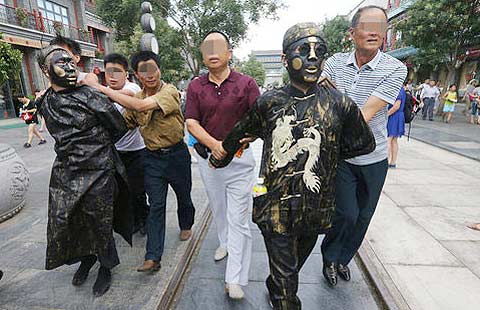Belief in building
Updated: 2014-07-22 07:34
By Hou Liqiang, Qi Xin and Zhang Yunbi (China Daily)
|
|||||||||||
China's oldest Buddhist temple is becoming a channel to boost religious study and strengthen friendship across borders, report Hou Liqiang and Qi Xin in Luoyang, Henan province and Zhang Yunbi in Beijing.
When graduate student Chen Xin visited the White Horse Temple in Luoyang of Henan province, she never expected to see shrines built in foreign styles there.
"The shrines were fabulous. We could experience exotic buildings and cultures. They also stimulated our interest to know more about Buddhism in these countries," said Chen, 30, from the Fourth Military Medical University.
The shrines at the White Horse Temple are built in the style of the Buddhist halls of India, Thailand and Myanmar. Myanmar President Thein Sein on June 30 inaugurated the Myanmar-style shrine, the latest one at the temple to be opened to the public.
Chen wished there were also Buddhists from these countries at the shrines whose activities would be able to give her a better idea and closer experience of their Buddhist culture.
Fortunately for devotees like her, more shrines in foreign styles are expected to be built in the White Horse Temple. The temple, established in AD 68, is considered the first Buddhist temple in China.
"We are trying to build as many shrines as possible in different styles and make full use of Buddhism as a channel to strengthen friendship with different countries," said Peng Yaping, director of Henan Administration for Religious Affairs.
According to an extension plan of the temple complex, more shrines or structures in foreign styles will be built in it by 2020. The International Buddhism Temple zone is expected to be large enough to accommodate another seven shrines or temples.
Following the Indian, Thai and Myanmar Buddha halls, the other foreign shrines will be funded by foreign governments, enterprises or religious groups. Several countries including Sri Lanka and Cambodia have expressed their interest in investing in similar programs.
White Horse Temple abbot Yinle said the private secretary of the prime minister of Sri Lanka has communicated with it regarding such investment and it is waiting for confirmation from the Sri Lankan authorities.
Wang Huijie, director of the Luoyang Administration for Religious Affairs, said there is also similar communication with Japan, the Republic of Korea and Nepal, with help from the Buddhist Association of China and scholars interested in Buddhism exchange.
Three students majoring in Buddhism from Thailand's Chulalongkorn University have arrived in the Thai-style shrine for a 10-month internship, Yinle said.
The Thai-style shrine, built in 1997 with 30 million yuan($4.83 million), is being extended and will be completed in September and reopened to the public soon after.
The shrine covers about 3,000 square meters and will be broadened into a temple complex of more than 10,000 sq m. Thai supporters provided most of the funding for the extension.
The White Horse Temple is expected to see more Buddhists from other countries, especially from those in Southeast Asia.
An international Buddhism research institute will also be built in the temple, Yinle said.
"With the shrines and temples in foreign styles acting as bridges, we will strengthen Buddhism communication with Southeast Asian countries, especially those countries that built the shrines," said Yinle.
"We will make full use of the White Horse Temple, the oldest temple in China, as a historical platform and invite Buddhists from Southeast Asia to give lectures here."
Buddhists of the White Horse Temple currently give lectures during the weekend. It is also planning to invite famous Buddhists nationwide and from Southeast Asia to lecture after the institute is completed, said Wang.
The shrines or temples built in foreign styles and the research institute, together with other extension projects, will make White Horse Temple the largest of its kind. The total area of the temple complex will be increased to 86.7 hectares.
Bridging role
Besides Buddhism communication, the temple is certainly becoming more important as a bridge for diplomatic ties.
Before Myanmar President Thein Sein, former Indian president Pratibha Patil as well as former Indian prime ministers P.V. Narasimha Rao and Atal Behari Vajpayee visited the temple.
More exchanges at the religious level are expected to help boost diplomacy and understanding across borders.
Huang Xianian, a researcher on Buddhism studies and cross-culture religious comparison at the Institute of World Religions under the Chinese Academy of Social Sciences, said religious contact between China and Southeast Asian nations is an "influential catalyst of great effectiveness for public diplomacy".
Especially during China's Tang Dynasty(AD618-907), booming cross-border religious exchanges between nations in China, South Asia and Southeast Asian nations prompted policymakers to upgrade grassroots-level exchanges to official relationships, and prominent religious figures played critical roles in it.
"Buddhism has long been one of the most influential religions in Southeast Asia and Northeast Asia, where it enjoys nationwide adoration ... Buddhism is one of the top resources for boosting diplomatic contacts with neighbors," he said.
The legacy of Buddhism continues to shape the landscape of many Southeast Asian nations such as Myanmar, Thailand and Sri Lanka. Cambodia's official religion is Theravada Buddhism and more than 93 percent of its residents are Buddhists.
In 1992, about 90 percent of the Myanmar population followed Buddhism and a deeper understanding of Buddhism's role in Myanmar leads to broader recognition in the country's evolving politics and society, said Li Chenyang, a professor of Southeast Asian studies at Yunnan University in southwestern China.
"The ways of thinking, moral standards, values, judgment and linguistic customs - many of them are still shaped by Buddhism. Images of high-ranking officials praying at a Buddhist temple also prevail on national TV," Li said.
The idea of developing Buddhism is gathering momentum in Asia and in addition to shared historical factors, its boost to tourism and economic growth is also welcomed, Huang said.
Amid a boom in the construction of exotic temples in China, Buddhists in the country are also expected to build more temples overseas to help "China's public diplomacy and promotion of Chinese culture".
Contact the writers at houliqiang@chinadaily.com.cn
Zhang Leilong contributed to the story.
(China Daily 07/22/2014 page6)
Today's Top News
Int'l investigation team on MH17 formed
Meat supplier of McDonald's, KFC suspended in Shanghai
Gaza death toll pass 100
Lunar rover is 'awake'
Burning wreckage, bodies scattered after jet downed
Xi makes plea for 'cyperpeace'
China's GDP growth 'in range'
Israeli forces roll into Gaza
Hot Topics
Lunar probe , China growth forecasts, Emission rules get tougher, China seen through 'colored lens', International board,
Editor's Picks

|

|

|

|

|

|





